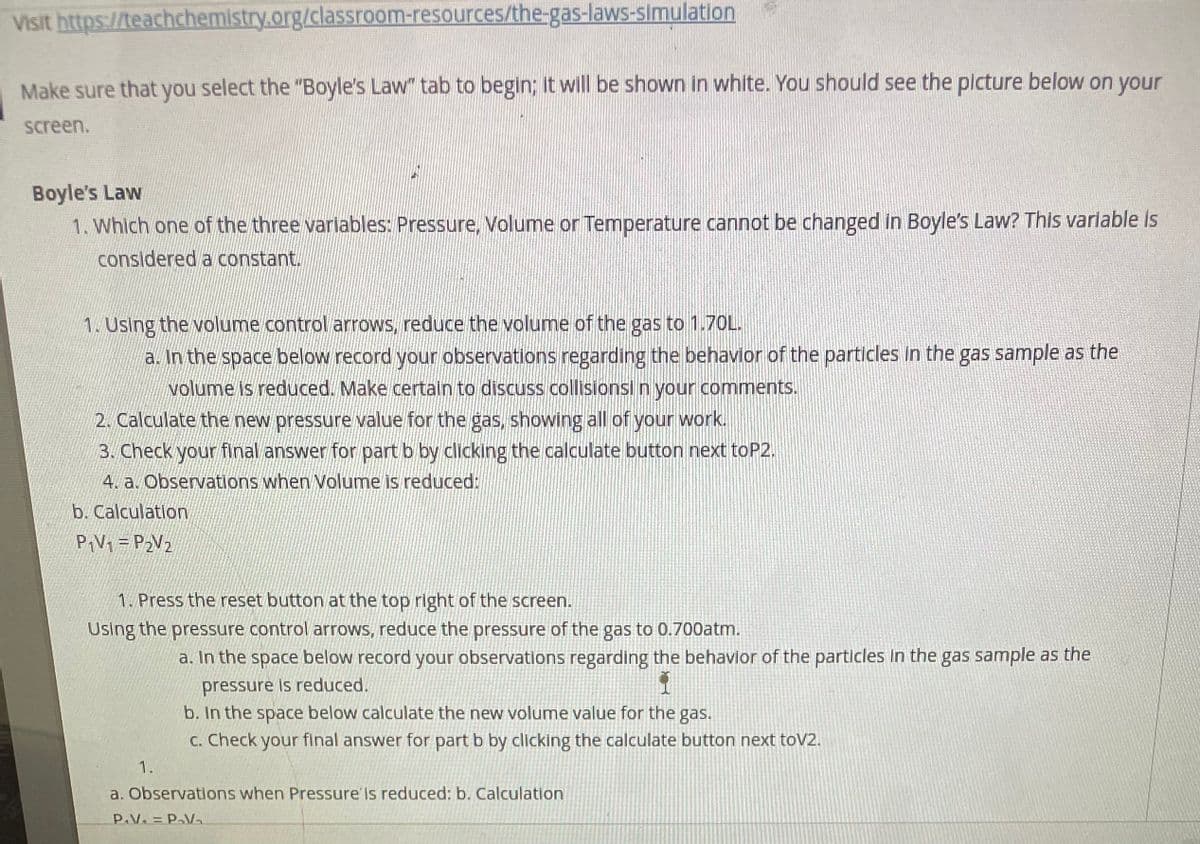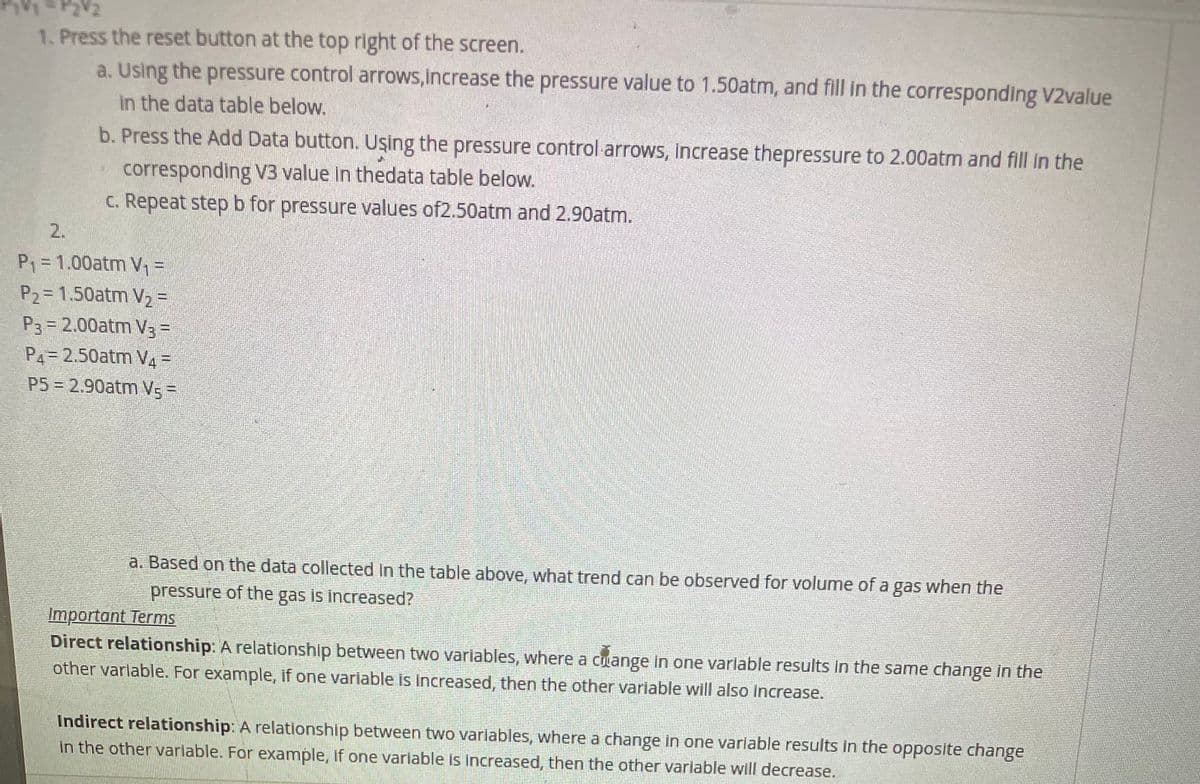1. Which one of the three varlables: Pressure, Volume or Temperature cannot be changed in Boyle's Law? This variable is considered a constant.
1. Which one of the three varlables: Pressure, Volume or Temperature cannot be changed in Boyle's Law? This variable is considered a constant.
Chemistry
10th Edition
ISBN:9781305957404
Author:Steven S. Zumdahl, Susan A. Zumdahl, Donald J. DeCoste
Publisher:Steven S. Zumdahl, Susan A. Zumdahl, Donald J. DeCoste
Chapter5: Gases
Section: Chapter Questions
Problem 156CWP: Which of the following statements is(are) true? a. If the number of moles of a gas is doubled, the...
Related questions
Question
In addition to the other
Considering the terms do the variables of pressure and volume have a direct or undercut relationship in Boyles law? Justify with data.
what will happen to the pressure of gas in a bottle if it was squeezed tightly, reducing the volume of gas by half. Explain

Transcribed Image Text:Visit https://teachchemistry.org/classroom-resources/the-gas-laws-simulation
Make sure that you select the "Boyle's Law" tab to begin; it will be shown in white. You should see the plcture below on your
screen.
Boyle's Law
1. Which one of the three variables: Pressure, Volume or Temperature cannot be changed in Boyle's Law? This varlable is
considered a constant.
1. Using the volume control arrows, reduce the volume of the gas to 1.7OL.
a. In the space below record your observations regarding the behavior of the particles In the gas sample as the
volume is reduced. Make certain to discuss collisionsi n your comments.
2. Calculate the new pressure value for the gas, showing all of your work.
3. Check your final answer for part b by clicking the calculate button next toP2.
4. a. Observations when Volume is reduced:
b. Calculation
PIV1 = P2V2
1. Press the reset button at the top right of the screen.
Using the pressure control arrows, reduce the pressure of the gas to 0.700atm.
a. In the space below record your observations regarding the behavior of the particles In the gas sample as the
pressure is reduced.
b. In the space below calculate the new volume value for the gas.
C. Check your final answer for part b by clicking the calculate button next toV2.
1.
a. Observations when Pressure' is reduced: b. Calculation
P.V. = P-V-

Transcribed Image Text:1. Press the reset button at the top right of the screen.
a. Using the pressure control arrows,increase the pressure value to 1.50atm, and fill in the corresponding V2value
in the data table below.
b. Press the Add Data button. Uşing the pressure control arrows, increase thepressure to 2.00atm and fll in the
corresponding V3 value in thedata table below.
C. Repeat stepb for pressure values of2.50atm and 2.90atm.
2.
P = 1.00atm V%=
P2= 1.50atm V2 3=
P3= 2.00atm V3=
P4=2.50atm V4 =
P5 = 2.90atm Vs=
a. Based on the data collected In the table above, what trend can be observed for volume of a gas when the
pressure of the gas is increased?
Important Terms
Direct relationship: A relationship between two variables, where a cuange in one varlable results in the same change in the
other varlable. For example, if one variable is increased, then the other variable will also increase.
Indirect relationship: A relationship between two varlables, where a change in one varlable results in the opposite change
in the other varlable. For example, if one variable is increased, then the other variable will decrease.
Expert Solution
This question has been solved!
Explore an expertly crafted, step-by-step solution for a thorough understanding of key concepts.
This is a popular solution!
Trending now
This is a popular solution!
Step by step
Solved in 3 steps

Knowledge Booster
Learn more about
Need a deep-dive on the concept behind this application? Look no further. Learn more about this topic, chemistry and related others by exploring similar questions and additional content below.Recommended textbooks for you

Chemistry
Chemistry
ISBN:
9781305957404
Author:
Steven S. Zumdahl, Susan A. Zumdahl, Donald J. DeCoste
Publisher:
Cengage Learning


Introductory Chemistry: A Foundation
Chemistry
ISBN:
9781337399425
Author:
Steven S. Zumdahl, Donald J. DeCoste
Publisher:
Cengage Learning

Chemistry
Chemistry
ISBN:
9781305957404
Author:
Steven S. Zumdahl, Susan A. Zumdahl, Donald J. DeCoste
Publisher:
Cengage Learning


Introductory Chemistry: A Foundation
Chemistry
ISBN:
9781337399425
Author:
Steven S. Zumdahl, Donald J. DeCoste
Publisher:
Cengage Learning

World of Chemistry, 3rd edition
Chemistry
ISBN:
9781133109655
Author:
Steven S. Zumdahl, Susan L. Zumdahl, Donald J. DeCoste
Publisher:
Brooks / Cole / Cengage Learning

Chemistry: Matter and Change
Chemistry
ISBN:
9780078746376
Author:
Dinah Zike, Laurel Dingrando, Nicholas Hainen, Cheryl Wistrom
Publisher:
Glencoe/McGraw-Hill School Pub Co

Chemistry for Engineering Students
Chemistry
ISBN:
9781337398909
Author:
Lawrence S. Brown, Tom Holme
Publisher:
Cengage Learning